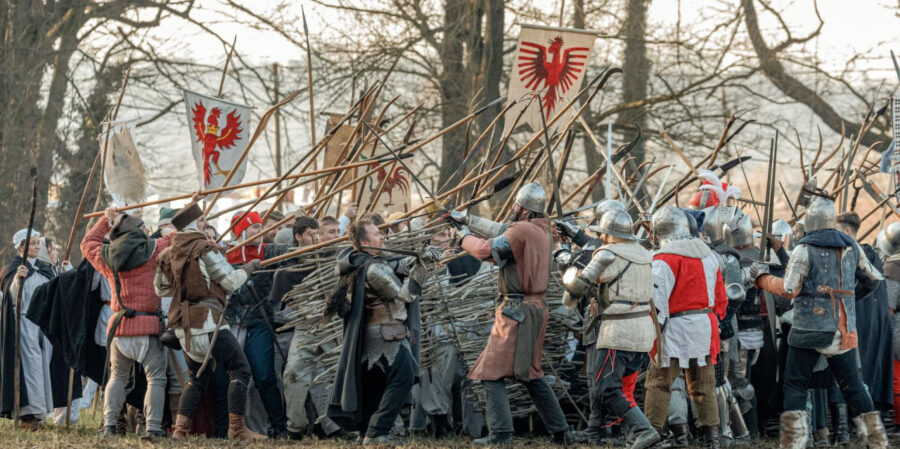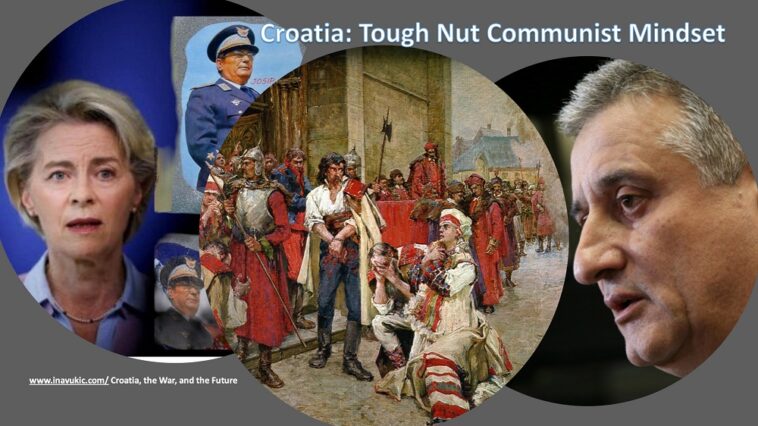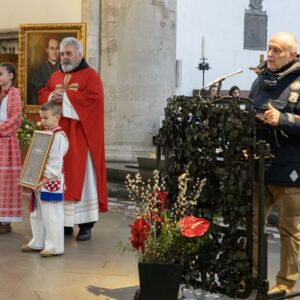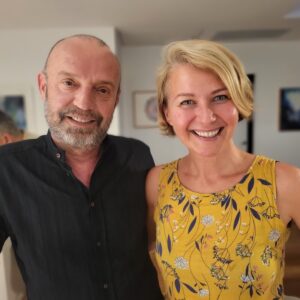
I turn to the Facebook post, dated 14 February 2023, by Tomislav Karamarko, who among other high roles is former Deputy Prime Minister of Croatia (from January to June 2016) and former Minister of Internal Affairs of Croatia (October 2008 to December 2011), who strongly acted in efforts to prosecute communist crimes in former Yugoslavia, Croatia, and paid dearly for that with his distinguished and most promising career in politics and leadership in 2016. One can safely assume that lustration or at least a functional class of lustration would have been on his agenda for Croatia were he not cut down by the political machinery that wheeled and dealt communist mindset and actions.
“Ursula von der Leyen is the president of the European Commission and Ognian Zlatev is the head of the European Commission’s representative office in Croatia, so I dedicate this Facebook post to them and their consciences. I don’t expect anything from local Europeans anyway, because most of them have a conflict of interest in relation to the topic I’m initiating.
Namely, on February 10, 2023, slobodadalmacija.hr published an article entitled ‘Did you know that there are 28 places with squares and streets that proudly bear the name of Marshal Tito in Croatia.’
So much materialisation and concrete mention of JB Tito, one of the biggest criminals of the 20th century, communist dictator, and henchman…
Can you stoop any lower and poorer, my homeland?
On September 19, 2019, the European Parliament adopted a resolution called ‘The Importance of European Remembrance for the Future of Europe’, which condemned and equated Nazi and communist crimes, and calls on all EU member states to carry out a clear and principled review of the crimes and acts of aggression they committed. totalitarian communist regimes and the Nazi regime. The Resolution also expresses concern because ‘in the public spaces of some member states (parks, squares, streets, etc.) there are still monuments glorifying totalitarian regimes.’
Could it be any clearer?
That is why I am publicly asking Mrs. Ursula von der Leyen and Mr. Ognian Zlatev, since nothing has been done to date (in Croatia), what are they doing so that the resolution of the European Parliament entitled ‘The Importance of European Remembrance for the Future of Europe’ of September 19, 2019, is finally implemented in the Republic of Croatia.
Isn’t it time for this mental-communist contamination to end…”
But its not only in public spaces that the underhanded and mean operations of communist Yugoslavia still exist in Croatia. There is also no effort whatsoever to correct the wrongs committed even with national symbols or heroes of Croatian freedom fight that spotted many centuries.
450 years ago, the great Croatian–Slovene Peasant Revolt ended. On February 15, 1573, the uprising’s leader Matija Gubec was brutally, torturously executed in the main square of Zagreb, the capital of Croatia, which at the time was part of the Habsburg Empire. During centuries that followed, the Peasant Revolt of 1573 continued to serve as a beacon of hope for change for the better, inspiring numerous pro-freedom actions, initiatives and movements in the region and beyond. While the Croatians fighting for an independent Croatia during World War Two embraced, naturally, Matija Gubec as their idol who symbolised their plights for freedom from the installed oppressive Yugoslavia conglomerate since 1918, Yugoslav communists (who fought for Croatia to remain within a Yugoslavia and subservient to Serbs), pretending to be on a saving and liberating mission of Croats, had the gall to take the name of Matija Gubec for two of their fighting brigades in World War Two; one in Croatia and one in Slovenia! Given that Gubec was a symbol of fight for freedom in both Croatia and Slovenia the communists stole him from Croats as their idol in battle to continue the enslavement of both Croatia and Slovenia by Serb-leadership-saturated communist Yugoslavia!
Since Gubec was seen almost exclusively as a fighter for the Croatian state, the right to a state was denied by the communists, considered to be simply minions of Russia/Stalin to co-opt him as a symbol of a leftist revolution had cut bitter anger and resentment in Croatian patriots.
As communists in Yugoslavia, not Croatian independence fighters, won the Second World War their control over Matija Gubec legacy was tightened and they pursued further changes in the interpretation of symbolism Matija Gubec represented. Their interpretation of Gubec as a social revolutionary (not freedom fighter) became the only version, and the history of the Communist Party of Croatia as part of Yugoslavia was written with the 1573 rebellion as the beginnings of a revolutionary movement leading to the Partisan triumph in 1945. Gubec became a chapter in the Partisan myth, and in 1973, the 400th anniversary of the peasant rebellion became an occasion not only to celebrate Gubec, but to reinforce the legitimacy of communist regime as (falsely) a people’s regime that liberated.
Looking back to 1990’s when Croatia fought to become independent from communist Yugoslavia, it is almost impossible to know the exact number of communists and former communists who favoured or opposed independence. Judging by what has developed politically and leadership-wise since year 2000 in Croatia it is, however, possible to know that many of those communists who did not oppose Croatia’s independence in 1990’s did so by hiding their greed for power and communist indoctrination at the time. Post 1991 independence referendum where almost 94% of Croatian voters voted favourably for secession from communist Yugoslavia it is widely believed that one third of Croatia’s communists favoured an independent Croatia, one third opposed it, and one third were undecided but went along with it. This stems from an estimate made by general elections results and various public statements, omissions to prosecute communist crimes and ongoing display of communist symbolism for which there is no legislative ban as there is for the WWII independence fighting Ustashe regime.
With the end of communism and the collapse of Yugoslavia, Gubec lost the political symbolism that had once inspired so-called revolutionaries to fight under his banner even outside Croatia. Under Croatia’s first democratically elected president, Franjo Tudjman, who was also from the Zagorje region, the cult of Gubec faded away. Gubec had essentially become a communist symbol and thus could not immediately be incorporated into the body of new (or renewed) political symbols that were required by an anti-communist and newly independent Croatia. In January 2004, the Zagorje district where the 1573 battle took place could not even raise enough money to fund anniversary activities to commemorate the event, which included a 3.5 kilometre walk from Gubec’s Linden Tree (where the peasant leaders allegedly met) to the site of the museum and a re-enactment of the trials of Franjo Tahy and Matija Gubec. Since then though the celebration of the anniversary of the uprising is done locally in Donja Stubica via a re-enactment of the unique and important battle and this year such celebration marked its 15th year.
One may say indeed, if it weren’t for the former communists or their indoctrinated descendants in government and in the presidential office since year 2000 Matija Gubec would have long ago been rehabilitated to his rightful place in history – as a hero of freedom fights of and for Croatian people.
Thankfully, the memory of Matija Gubec has not died out, even if the localised celebrations by way of re-enactments of the Battle of Stubica and cruel death keep the remembrance away from the national level. Since the main goal of this 16th century uprising was equality among human beings through the abolition of feudalism and an end to institutionalised corruption, including unreasonable taxation and abuse of women it has quite significant similarity with the Croatian fight for Independence during World War Two as well as the Croatian 1990’s Homeland War battles that ensued after most of the Croatian people were no longer willing to suffer oppression by Serb-led communists in power. It’s not an easy feat to return to its rightful glory that which has been desecrated by communists, such as the symbol of Gubec. Widespread corruption (and unwillingness to confront and disable it) and communist mindset are evidently too strong at the leadership of Croatia for things to change to better even within the next decade. But if eligible voters get smart enough, they could draw the start line for real change even as early as next year. Ina Vukic




